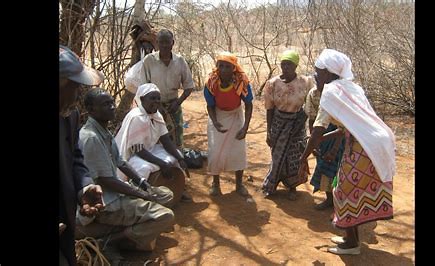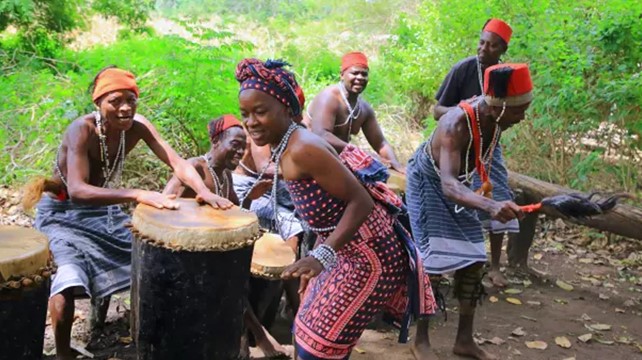KENYA
As everywhere in Africa, traditional music and dance punctuates village life. Each ethnic group has a particular style. The difference is sometimes subtle for the layman. The common point is the use of percussion. The drum or ngoma gave its name to this traditional music
Two ethnic groups stand out for the vitality of their musical traditions:
– The Giriama and the Digo on the coast. They are excellent dancers and talented percussionists..
– In the lake region, the Luo have a particularly keen sense of celebration. The richness of their traditional repertoire has largely influenced contemporary Kenyan groups. Their neighbors, the Luyia, are known for the syncopated rhythm of their percussion, led by a drum called sukuti.
– A special case: Maasai dances. A spectacular warrior ritual in the style of a collective trance. The group of moranes leaps into the air, spear in hand. It expresses its strength and courage in a gregarious song in several voices. Groups of Maasai have made a lucrative business out of it in the large national parks.
Kenya is home to a variety of passage ceremonies that mark important milestones in life, such as birth, circumcision, marriage, and death. Each of these ceremonies is an occasion for colourful and festive celebrations. The Kikuyu circumcision ceremony, for example, is a crucial milestone for young boys, marking their passage into adulthood. This tradition is followed by dancing, singing, and feasting.
Among the most remarkable dances, we can mention the Adamu, a jumping dance of the Maasai; the Mwomboko, a couple dance of the Agikuyu, generally performed by the oldest members of the community; the Isikuti, a luhya tradition with energetic and rapid movements of the shoulders, waist and feet (UNESCO heritage); or the Chakacha, very common among the Swahilis. As well as Kilumi among the Kamba and Mwazindika (UNESCO heritage) among the Dawida
References
Routard PassionMonde Petit Futé
List of Dances
Kilumi
kilumi
The Akamba are known for their use, familiarity, and knowledge of ritual traditions that are interwoven into their society.
The most famous traditional dance in Kamba people is Kilumi, which was categorized into five to match the occasions on which it would be performed: Worship, Cleansing, Initiation, Therapeutic Kilumi and Pray for rain.
There is often the impression that rain dance practices have completely disappeared from Kenyan life. However, the dance rite is still embedded into the life of some Kenyans in the rural areas. Rain dancing continues in modern Kenya because of the reoccurring drought; therefore, historically there has been a space for people to retain and memorialize the practice.
Kilumi is a healing rite designed to restore environmental balance through spiritual blessings, movement, offering, and prayers and the dance has been present since the very beginning of Kamba existence. This ritual emphasizes symbolic dance movements as a key force in achieving the goal of the ceremony. The heart of the dance ritual is its spiritual essence; in fact, it is the spiritual aspect that distinguishes the dances of Africans and their descendants worldwide.
The dancers’ bodies are the dominant symbol, and the power associated with the dancers’ movements provide the necessary energy to help invoke the spirits and healing. The final role is that of the unseen rain spirit, which may or may not attend, but, as mentioned earlier, is a key force in whether or not the community can expect future rain.
The duration of the libation is dependent upon the elder’s satisfaction that a suitable prayer and call has been initiated. As witnesses, the elders initiated libations, poured milk for the ancestors, and then drank from the calabash. They use milk, in particular, in these ceremonies because the Wakamba view milk as having the properties necessary for more blessings. During the ceremony, only men were allowed to drink the milk.
After this opening prayer and libation, musicians began to play the drums and other instruments, creating a slow and synchronized rhythm at the same slow tempo and cycle length. The elderly female dancers are positioned in opposite areas, and they slowly move into the dance ritual space in unison. The spiritual seriousness of the ritual is seen on the faces of participants.
The dance had to be perfect for successful intervention with the spirit being called upon.
Traditionally, Kilumi was performed by older women, but men also participate in the modern society settings. The drum is used by women; men also can use the drum and they dance but only those who were aware of the “spiritual words”.
This dance also involves beating several dreams in the event of a calamity in the Kamba community.
For example, a prolonged drought can prompt the Kilumi dance, where older men and women partake to be seech the spiritual realm to bring rain. The dance is scheduled for the evenings after meals and involves slaughtering a goat and a cow.
The dance continues until one of the dancers becomes possessed, a sign that the gods have communicated the solution to the prevailing problem.
Additionally, the Kilumi dance was performed after burials to cleanse bereaved families without instruments or body movements.
The drum of this dance is made from wood of the “muinga” tree, carved with a “thia” and finished with a azde (ngoma).
KENYA
Region:
Eastern Kenya
Ethnic group: Kamba

References
Read
“The Kilumi Rain Dance in Modern Kenya”, by Mickie Mwanzia Koster, Ph.D. Department of Political Science and History University of Texas at Tyler, The Journal of Pan African Studies, vol.4, no.6, September 2011
Crédit : Tim Gregory
Mwazindika
Meaning and Importance:
Nestled in the scenic landscapes of Taita Taveta County, Kenya, the Mwazindika stands as a cultural treasure, a testament to the resilience of the Dawida community. Beyond its captivating dance, songs, and drumbeats, this ancient ritual offers a profound glimpse into their rich heritage, yet faces an urgent need for safeguarding.
The Mwazindika, more than a spiritual dance, intertwines with the daily life of the Dawida community, marking milestones and providing solace in times of calamity. The ritual’s pulsating rhythms and dramatic flair create an electrifying atmosphere, while Chofi, a symbolic traditional brew, symbolizes a connection to the past and reverence for ancestors.
Traditionally, the mwazindika was also used to exorcise evil spirits especially in women. The dance has in fact remained a cultural showcase of all times, and no public function in Taita is complete without the Mwazindika dance being performed , usually to the excitement and ululation of all. Other accompaniments include jingles which are fastened on the dancers’ ankles and ululations from women dancers. In some places such as Bura in Taita, there is a variation of Mwazindika locally known as “gonda”, where a wooded board laid on the ground is truck rhythmically with dry wooden poles.
“Traditionally, male elders played the drums while the women danced and ululated. In some parts of Taita it was taboo for women to play the drums, but nowadays it’s not uncommon to see women also playing the drums. A lot of things have changed, but the vibrancy and heartrending nature of Mwazindika remains,” says Mzee Dishon Mwalui, a Taita elder.
In the days of yore, Mwazindika was played on various occasions both to celebrate life, for entertainment and also to appease the gods of the Wadawida so that they could bless the Taita community.
The dance was performed during the birth of a baby boy, especially from a prominent family such as a chief’s family where the baby boy was expected to be an heir apparent.
According to Mzee Mwalui, the dance would be performed to the visitors who turned up to pay homage to the new born baby to appease the gods so that the boy could be inspired to be a wise leader in future.
Mwazindika was also performed during circumcision rites for both boys and girls during the years of yore, a rite of passage that bespoke a foray into adulthood.
Traditionally, when Taita youth reached puberty and were about to be ushered into adult life, he or she was secluded( kuaikwa) where they were taught the secrets of adult life by elders.
When they came out of seclusion a ceremony would be conducted to welcome them back into the large community during which the Mwazindika was performed as well as beer drinking by the elders.
The dance was also performed during harvest time as a thanksgiving to the gods for blessing the community with food as well as when Taita warriors returned from war with their aggressive neighbours.
“When Taita fighters returned from battle a big ceremony would be held to welcome them back. There would be beer drinking, pouring libations to the ancestors which would be followed by the sharing of the livestock and other properties that the fighters had taken away from their enemies including women. This was called “kusara”. This time of celebrating victory would be marked by mwazindika dance and beer drinking by elders and the seers” says Mzee Mwalui.
However, one of the prime functions of the mwazindika dance was excorcising evil spirits, pepo, especially in women.
The affected women would be given a slightly sickening herbal concoction called “mwalola” and invited to performs the dance as the seers and elders chanted and admonished the spirits to leave the victims. The dance would go on and on till the victim went into a state of delirium and would collapse. She would then have cold water poured on her body till she was still and calm. After a while the victim would come back to her senses and walk away free from.
Threat and Safeguard:
In February 2024, a UNESCO-led delegation visited Taita Taveta County to explore the secrets of this dance. Their goal was to name it to UNESCO’s intangible cultural heritage.
The community gave its approval and informed consent, allowing the Kenyan government to continue the appointment.
KENYA
Region:
Taita Taveta
Ethnic group:
Dawida

